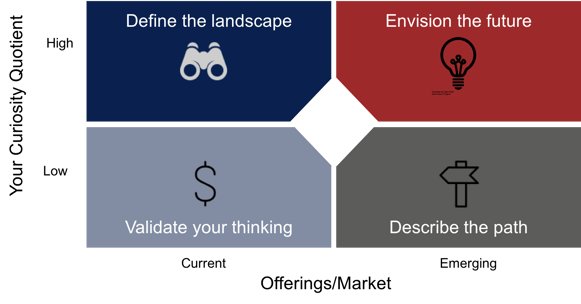(Part 2 of 3)
In the first blog of this Asking Great Questions series, I talked about the need or rationale for asking questions. Great questions can undoubtedly be great tools in the right hands. However, as any good craftsperson can tell you, the key to getting the most out of your tools is knowing how to use them. Using a hammer to drive in a screw never works, no matter how hard you pound.
The same is true for questions. Job one is knowing your question’s purpose—what type of conversation are you planning? What kind of answers are you looking for? Only then, can you select the very best questions for the conversation.
Job two is knowing what’s in it for your customer. That is, why should they invest their valuable time talking to you in the first place? Today’s customers are impatient and demanding—they have little tolerance for poorly-prepared suppliers. However, conversations grounded in informed curiosity can reveal compelling insights for customers--uncovering new sources of value or emerging opportunities.
We'd like to invite you to increase your curiosity. Consider the following guide to help you define your customer conversation and craft the very best questions to accomplish your goals.
Curiosity-driven ConversationsSM

Each of the four conversations have different characteristics—and question types. Let’s explore each one. I’ve used the goal of identifying what’s important and valuable to customers as an example.
- Validate your thinking. Customers buy your offerings for a reason—to increase revenue, reduce costs or mitigate risk. Your job is to first understand which is relevant and then attach a dollar sign to each of these value components.
Use open-ended clarifying questions to collect essential information, such as “What would that mean for your business? “What would be the impact if_____?” And, simply follow-up with “Why?”
- Define your full impact. Go on a value hunt to explore new sources of value, new groups or stakeholders that might benefit from your offerings.
Use questions that expand the conversation, such as “Who else might benefit from this solution?” “Who else may have an important perspective?” or “What might be another explanation for this issue?” Or, “If this is not solved, then what?”
- Envision the future. These conversations often involve senior executives or prospects, where your goal is to engage the listener in a compelling discussion about the future.
Use insight-led questions, grounded in a solid understanding of the customer’s business and marketplace, to engage high-level discussions, such as “I can see this trend in your market, what is your vision for this business? What makes you well-positioned to execute and what are the challenges?”
- Describe that path for making this future real. Here, your conversation moves from a vision to the action plan for you and your customer to realize the vision.
Use questions that both define the roadmap and detail the benefits, such as “How would your business change?” “What new markets or customers could you reach?” or “What new skills or capabilities would you need to develop?”
Effective questions don’t have to be over-engineered, rather they should be thoughtful and relevant to take the listener from passive listening to active engagement. They demonstrate that you care to invest time in research to ensure the conversation is valuable to both parties. With the right questions, you will separate yourself from the unprofessional product pushers relying on their shiny objects to ‘wow’ the customer.
The last blog in the series will explore embedding Curiosity-driven ConversationsSM into your sales process, and how well-chosen questions can enhance your customer relationships, extend your impact across the entire customer organization, and take the first steps in building a trusted partner relationship with key accounts.
Be sure to subscribe to our blog to get notified about the last blog in the series.

.jpg)